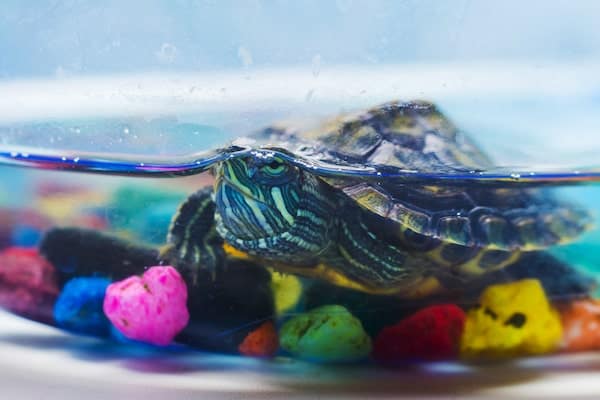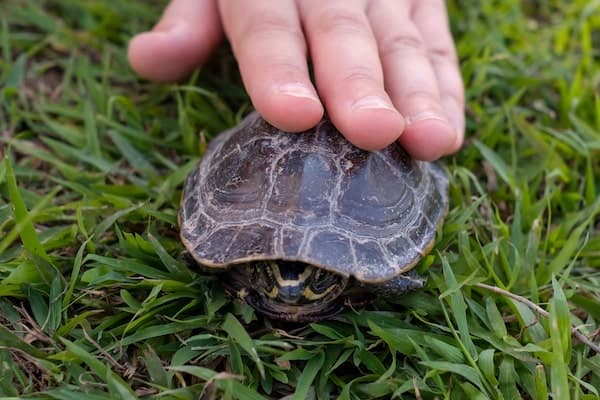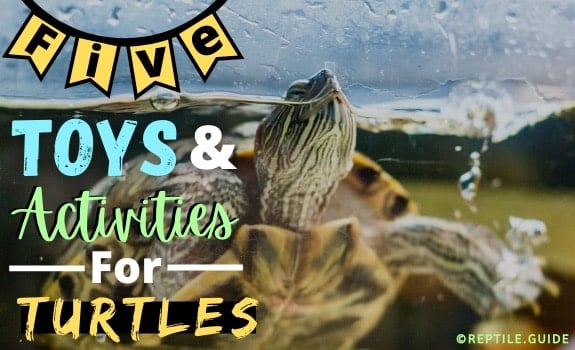It’s a common belief that turtles are slow, lazy, and hate interaction—a common belief as well as a common misconception.
Once they become accustomed to their surroundings and owners, turtles are actually very personable and interactive little reptiles (opens in new tab)!
The norm for captive turtles is typically a bare-bones, bare-bottomed aquarium with a powerful filter and one basking spot. But as animal lovers, surely we CAN do better!
Believe it or not, most turtles take every opportunity to entertain themselves with new toys, areas to explore, and foods to enjoy.
In fact, researchers have even found that turtles can benefit from enrichment in much the same way as other animals like mammals.
And while turtle enrichment activities can be challenging to imagine, we’re here to bring you some ideas to get you started on your path to spoiling your turtle and enriching its life!
In This Article
Food
Most of a wild turtle’s activities and behaviors are associated with hunting or foraging for sustenance. Recreating this daily grind in captivity is one of the MOST fun, rewarding, and natural ways to enrich your turtle’s life!
Active live feeders, like crickets, earthworms, fish, and roaches, are excellent sources of enrichment and activity. Any container with a solid, smooth side that’s at least 24″ high will prevent critters from escaping while your turtle hunts with glee.
Of course, these options are only suitable for carnivorous or omnivorous species of turtle and tortoise. No worries! We’ve still got you covered.
For tortoises and vegetarian turtles, you can make a “burrito,” where their favorite fruit or other delicious options are tightly wrapped up in large banana leaves or kale?
Your turtle will either have to eat the healthy greens to get to the delightful inside OR figure out how to unwrap the goodies for themself!
To simulate the never-ending natural search for food in the wild, you could feed your turtle somewhere new or even divide the same meal into multiple spots.
If you have the time and space, you can even consider growing a garden of turtle-safe grasses, herbs, flowers, and vegetables where he can forage to his heart’s content.
🤓 Expert Tip: Want to give your aquatic turtle that same hunting experience? Simply put some live feeders on a floating log or basking spot and watch in amazement as they get in some pull-ups whilst pursuing their prey!
Toys

Puzzle feeders made from balls with holes are a GREAT way to incorporate mealtime and playtime into one activity.
Depending on the size and species of turtle that you own, you could try a Wiffle ball, cat lattice ball, dog treat dispenser, baby toy, or even a horse toy for giant tortoises.
There are several commercially available treat-dispensing toys that were designed specifically for turtles.
Stuff the ball with your turtle’s favorite food or treat, so they randomly dispense while she pushes it around on land or in the water!
For live insects and land-based play, fill the toy with some balled up paper to increase the difficulty.
Many turtles enjoy different sizes, colors, textures, and shapes of rocks and shells placed in the aquarium or terrarium. Some love piling them all up together, while others take joy in pushing them around the habitat.
Floating bath toys also make GREAT toys for aquatic turtles and even tortoises if you need to keep them occupied during a soak.
Enclosure Set Up
While the options for turtle toys may seem a bit limited, their enclosure decor is where you can go wild!
The more large rocks, caves, logs, substrate, and plants you use, the happier, safer, and entertained your turtle will feel.
Many species, both aquatic and terrestrial, love to dig. Play sand is an appreciated substrate in aquariums; be sure that your turtle does NOT take to ingesting the sand.
Your terrestrial turtle would be delighted to find a container of coconut coir or organic topsoil to dig to their heart’s content. With a little ingenuity, you could even create a ramp for your aquatic turtle to access a moist dig box.
While there’s no such thing as an arboreal turtle, most species appreciate the challenge of climbing to the top of a low mound of rocks, logs, or substrate. Stones offer the added benefit of giving your terrestrial species a free nail filing!
Both water and land-based turtles need hiding areas to feel secure.
Get creative with (or purchase manufactured) rock caves, hollow half logs, and artificial or natural plants and bushes. Put new substrate, like dampened sphagnum moss, in some of the hides.
Tortoises should have a shallow water dish that they can climb into and soak in, and aquatic turtles should have at least one dry basking spot – more is better.
Different environments, temperatures, humidity levels, and substrate textures allow your turtle to interact with its environment, think about what it prefers, and explore.
To learn more about setting up the perfect home for your turtle, check out our best turtle tank ideas!
Outdoor Adventures

Nothing beats the great outdoors!
Bringing your pet turtle outside gives them a chance to enjoy things they would never experience indoors: fresh air, natural sunlight, the sight and scent of wild animals, foraging opportunities, and much more.
Outdoor adventures are ONLY appropriate for turtles that are at least partially terrestrial.
That is, of course… unless you’d like to build your aquatic turtle an outdoor pond! That is, perhaps, the *BEST* toy for any pet turtle.
If you’re worried about your little guy escaping your supervision while on outdoor excursions, you can even purchase a harness and leash that’s specially designed to fit securely on your turtle’s shell.
After all, it’s not like you can simply call them back to you so its best to exercise precaution and a watchful eye.
Interaction
Many turtles become stressed from excessive touching and handling, but not all of them…
Some turtles enjoy being scratched on their shell or neck. If yours does, a toothbrush is a great sensory item for mutual interaction that also serves double duty for cleaning your pet’s shell.
Other individuals that are less “hands-on” still might enjoy chasing your hand around. Be sure to stick to the other side of their glass enclosure wall so that you’re safe from nips!
As you can see, with a little ingenuity, imagination, and studying of your pet’s natural habitat and behaviors, there are so many opportunities for play, enrichment, and bonding with your turtle! Who would’ve ever thought?
